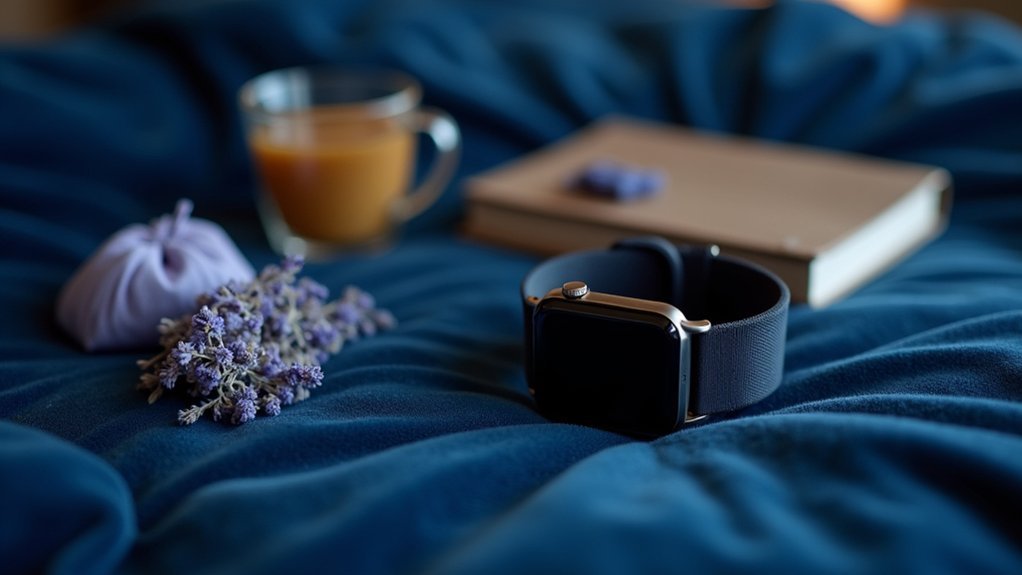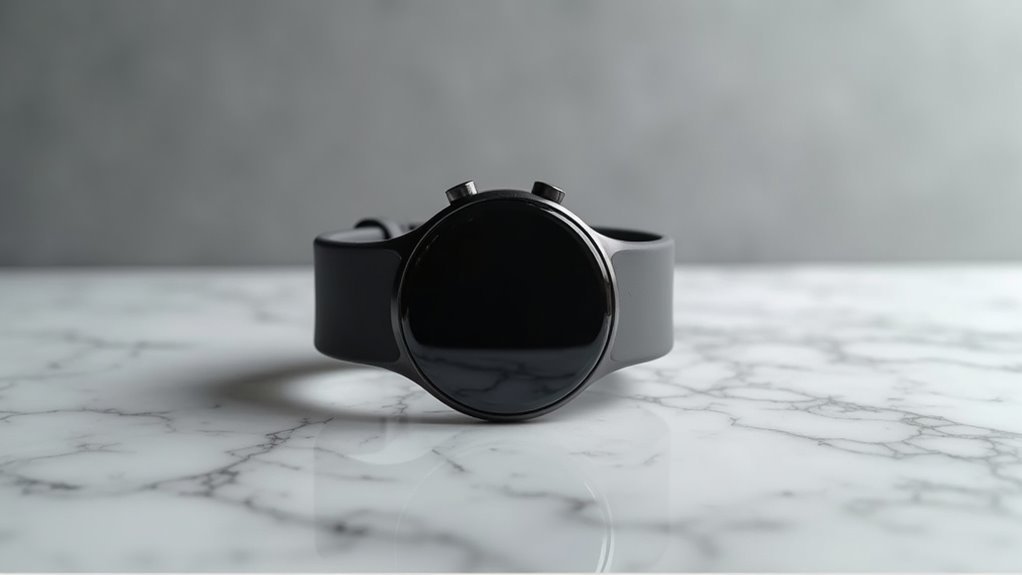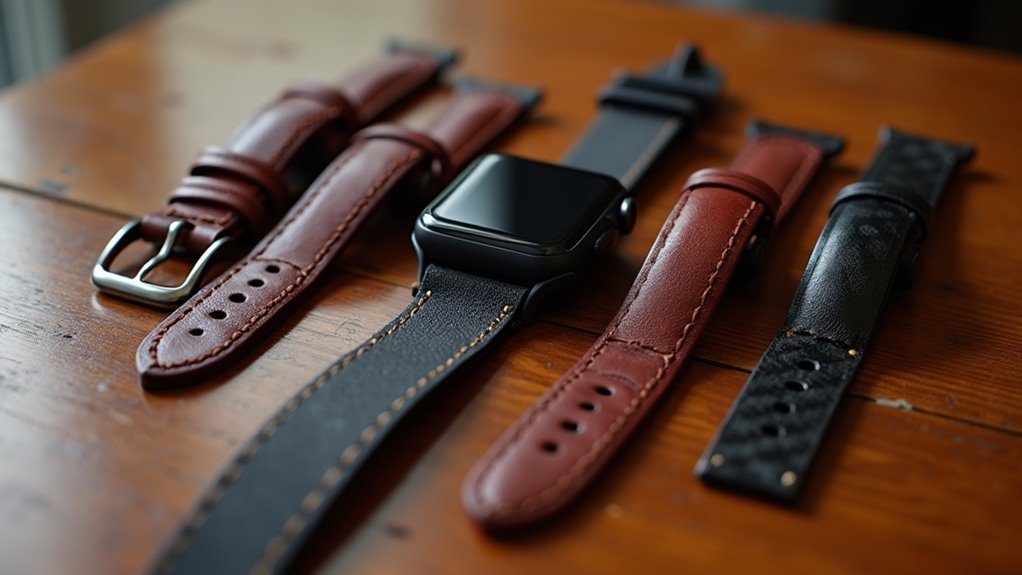Your smartwatch transforms your wrist into a sophisticated sleep laboratory, tracking REM sleep patterns for memory consolidation insights, monitoring heart rate variability with 81-96% clinical accuracy, and calculating sleep efficiency by analyzing total sleep time versus bed time. You’ll receive intelligent alerts for sleep stage shifts, detailed deep sleep recovery metrics, precise sleep onset latency measurements, and seamless cross-platform data integration with predictive trend visualization. These advanced features open up extensive sleep pattern analysis that’ll reveal exactly how to optimize your nightly recovery.
REM Sleep Detection and Memory Consolidation Tracking
Modern smartwatches increasingly leverage sophisticated algorithms and sensor technology to detect REM sleep stages, offering users valuable insights into one of the most essential phases of their sleep cycle.
Using accelerometers and heart rate sensors, these devices can identify when you’re experiencing the brain activity patterns characteristic of REM sleep, which are vital for memory consolidation and cognitive processing.
You’ll find that tracking your REM sleep helps you understand how well your brain processes and stores information from the day.
When your REM sleep gets disrupted, it can greatly impact your memory and cognitive functions.
Your smartwatch’s data analysis can reveal patterns in REM sleep duration and quality, alerting you to potential sleep health issues that might affect your mental performance. However, these devices rely on algorithms for interpretation, which can lead to inaccuracies in the sleep stage estimations they provide.
Advanced Heart Rate and Respiratory Pattern Monitoring
Beyond identifying REM sleep patterns, your smartwatch’s heart rate and respiratory monitoring capabilities provide deeper physiological insights into your sleep quality. Your device continuously tracks heart rate variability (HRV), which reflects your autonomic nervous system activity and stress recovery during sleep. Modern smartwatches achieve 81-96% accuracy in sleep detection when validated against clinical polysomnography. The Apple Watch Series 10 includes an FDA-cleared Sleep Apnea Detection feature that enhances the clinical relevance of consumer sleep tracking devices.
| Monitoring Feature | Technology Used | Health Insight |
|---|---|---|
| Heart Rate Variability | PPG Sensors | Stress Recovery Assessment |
| Respiratory Rate | Chest Movement Detection | Sleep Apnea Indicators |
| Breathing Irregularities | Multi-sensor Fusion | Airway Obstruction Signs |
| Cardiovascular Patterns | Optical Blood Flow | Arrhythmia Detection |
| Sleep Stage Estimation | Machine Learning Algorithms | Overall Sleep Quality |
Your smartwatch alerts you to abnormal patterns, helping identify potential sleep disorders like sleep apnea before they require clinical intervention.
Sleep Efficiency and Total Sleep Time Analysis
Your smartwatch calculates sleep efficiency by dividing your total sleep time by the hours you spent in bed, giving you a percentage that reveals how well you’re actually sleeping.
You’ll see your total sleep duration tracked nightly, allowing you to monitor whether you’re consistently meeting your sleep goals.
These metrics work together to show clear patterns over time, helping you identify trends in your sleep quality and duration that might otherwise go unnoticed. Sleep trackers estimate sleep based on measured inactivity rather than direct measurement, so understanding this limitation helps you interpret your data more effectively.
Sleep Efficiency Percentage Tracking
Sleep efficiency percentage represents one of the most telling indicators of your nightly rest quality, measuring the ratio of actual sleep time to total time spent in bed.
Your smartwatch calculates this metric using accelerometers that detect movement patterns and optical sensors monitoring heart rate variability to distinguish between sleep and wake states. You’ll receive a standardized percentage that helps you compare sleep quality across different nights and identify potential issues like sleep fragmentation or insomnia.
Leading devices like Apple Watch Series 8, Fitbit Charge 6, and Samsung Galaxy Watch 6 integrate this tracking with personalized coaching recommendations. The Garmin Venu 2 enhances this analysis with body battery energy monitoring that correlates your sleep efficiency with daily energy levels.
However, you should remember that accuracy depends on proper device wear and sensor quality, making these tools better for trend analysis than clinical diagnosis.
Total Sleep Duration Monitoring
While sleep efficiency reveals the quality of your rest, total sleep duration monitoring focuses on the fundamental question of how much sleep you’re actually getting each night.
Your smartwatch uses accelerometer data and heart rate sensors to distinguish between actual sleep time and time spent in bed. This distinction matters because lying awake doesn’t count toward restorative sleep.
The device analyzes movement patterns and physiological shifts to determine sleep onset and wake times. You’ll see your total sleep displayed through graphs and timelines, with trends tracked over weeks and months.
This data helps identify chronic sleep deprivation patterns and compares your habits against recommended guidelines. Understanding these sleep patterns through comprehensive tracking enables you to make informed adjustments to your nightly routine. While accuracy can vary due to movement artifacts, it’s invaluable for spotting concerning sleep duration trends.
Sleep Pattern Trend Analysis
Beyond tracking single nights, smartwatches excel at revealing long-term sleep patterns through sophisticated trend analysis that combines sleep efficiency and total sleep time data.
You’ll discover how machine learning algorithms adapt to your unique sleep patterns over time, providing increasingly personalized insights. The devices calculate your sleep efficiency as a percentage—time asleep versus time in bed—helping you identify trends in sleep quality.
Efficient sleep above 85% indicates good restorative rest, while patterns below 75% may signal sleep fragmentation or health issues. Night-to-night variability becomes meaningful when viewed as trends rather than isolated incidents.
You can spot correlations between lifestyle factors and sleep efficiency changes, enabling data-driven improvements to your sleep hygiene and overall rest quality. These insights function as your personal sleep lab, offering detailed analysis previously accessible only through professional sleep studies.
Intelligent Sleep Stage Transition Alerts

As your smartwatch continuously monitors your sleep throughout the night, its intelligent change alert system tracks the subtle shifts between different sleep stages using data from accelerometers, heart rate monitors, SpO2 sensors, and skin temperature sensors.
Machine learning algorithms analyze heart rate variability, movement patterns, and blood oxygen fluctuations to detect changes between light sleep, deep sleep, REM, and awake periods.
These alerts notify you when abnormal or prolonged changes occur, suggesting fragmented sleep quality. You’ll receive timely feedback on irregular patterns that might indicate sleep disorders like sleep apnea.
The system helps you understand your personal sleep architecture, enabling behavioral adjustments to reduce nighttime awakenings and optimize bedtime routines for more stable progression through restorative sleep stages. By monitoring these 4 stages of sleep comprehensively, your smartwatch provides detailed insights into your complete sleep cycle patterns.
Deep Sleep Recovery Metrics and Duration Tracking
Your smartwatch tracks deep sleep duration by measuring how long you spend in this critical recovery phase each night.
It monitors your physical recovery by analyzing heart rate variability, movement patterns, and breathing changes that indicate restorative sleep quality.
These metrics help you understand whether you’re getting enough deep sleep to fully recover from daily physical and mental demands. Advanced devices can track all four stages of sleep including slow wave sleep, REM, light sleep, and awake periods with high precision.
Deep Sleep Duration Measurement
When you’re tracking your sleep recovery, deep sleep duration measurement stands as one of the most critical metrics your smartwatch can provide. Your device continuously monitors these restorative sleep phases, which are essential for physical and cognitive recovery.
You’ll receive real-time data that detects fragmented or shortened deep sleep periods affecting your overall recovery. Your smartwatch quantifies nightly changes in deep sleep time, helping you identify pattern disruptions or improvements.
Through sleep stage segmentation, you’ll see deep sleep duration alongside light and REM phases for thorough sleep architecture insights. Extended tracking across weeks supports long-term trend analysis for health optimization.
However, you should know that wearables estimate deep sleep indirectly using heart rate, movement, and skin temperature rather than direct EEG signals. Research shows that smartwatches demonstrate moderate agreement with clinical sleep studies when measuring deep sleep duration, though they may overestimate actual sleep time.
Physical Recovery Tracking
Beyond simply measuring how long you spend in deep sleep, smartwatches now analyze the quality of physical recovery happening during these restorative periods. Your device monitors key physiological markers to determine how effectively your body’s repairing itself during sleep.
Modern smartwatches track physical recovery through several sophisticated metrics:
- Heart Rate Variability (HRV) – Measures your nervous system’s recovery from daily stress and physical exertion.
- Blood Oxygen Levels – Monitors oxygen saturation to assess sleep quality and recovery effectiveness.
- Sleep Stage Analysis – Distinguishes between light, deep, and REM sleep phases for thorough recovery insights.
- Stress Level Integration – Combines sleep data with stress monitoring for holistic recovery assessment.
While these devices aren’t as accurate as professional sleep studies, they’ll give you valuable insights into your body’s recovery patterns without expensive medical equipment. Wearable trackers generally provide superior accuracy compared to non-wearable alternatives due to their direct skin contact for monitoring physiological signals.
Sleep Onset Latency and Wake Pattern Recognition
Since falling asleep quickly and staying asleep throughout the night are key indicators of sleep quality, modern smartwatches have developed sophisticated algorithms to track your sleep onset latency (SOL) and wake patterns.
SOL measures the time from when you go to bed until your device detects the first sleep stage, providing essential insights into how efficiently you fall asleep.
Consumer sleep devices calculate SOL as the delay between bedtime and sleep onset, though methods vary slightly across brands. However, actigraphy has limited validity in accurately measuring sleep onset latency compared to clinical sleep studies.
Advanced smartwatches like the Fatigue Science Readiband and Fitbit Alta HR demonstrate sleep/wake performance comparable to clinical-grade equipment.
Cross-Platform Data Integration and Trend Visualization
Understanding your sleep onset patterns becomes considerably more valuable when you can view this data alongside thorough trends from multiple devices and platforms.
Sleep data becomes truly powerful when combined with comprehensive trends across multiple devices and platforms for deeper insights.
Modern smartwatches excel at integrating with cross-platform ecosystems, automatically syncing your sleep data to cloud services like AWS for seamless analysis across devices.
You’ll benefit from extensive trend visualization through several key integrations:
- Multi-device synchronization – Your Garmin or similar wearable uploads PPG, HRV, and accelerometer data automatically to platforms like Labfront.
- Advanced visualization tools – Tableau and Power BI transform raw sleep data into interactive dashboards.
- Predictive analytics – AI-powered insights analyze historical patterns to forecast sleep trends. Research platforms now utilize beat-to-beat interval data to provide more granular insights into sleep quality variations.
- Cross-platform compatibility – React Native and Flutter frameworks guarantee your data works across iOS and Android seamlessly.
These integrations provide actionable insights into your long-term sleep health patterns.
Frequently Asked Questions
How Long Should I Wear My Smartwatch Before Sleep Tracking Becomes Accurate?
You’ll need to wear your smartwatch consistently for at least two weeks before sleep tracking becomes accurate. Continuous nightly wear allows the device to calibrate and learn your specific sleep patterns.
Can Smartwatches Detect Sleep Apnea as Effectively as Medical Devices?
Smartwatches can’t match medical devices’ diagnostic accuracy. While they’re highly effective for screening sleep apnea with 75-96% sensitivity, you’ll still need professional sleep studies for official diagnosis and treatment planning.
Do Smartwatch Sleep Sensors Work Properly With Different Sleeping Positions?
Your smartwatch’s sleep sensors work differently depending on how you sleep. Side sleeping may reduce movement detection accuracy, while stomach sleeping creates the most tracking challenges due to increased movement patterns.
Which Smartwatch Brands Offer the Most Comfortable Designs for Overnight Wear?
You’ll find Apple Watch SE 2 and Withings Scanwatch 2 offer the most comfortable overnight designs. They’re lightweight, feature breathable straps, and have extended battery life for uninterrupted sleep tracking.
How Much Does Sleep Tracking Feature Usage Affect Smartwatch Battery Life?
Sleep tracking typically drains 20-25% of your smartwatch’s battery overnight. You’ll need at least 30% charge before sleeping, and features like continuous heart rate monitoring and always-on displays increase consumption considerably.
In Summary
You’ll transform your sleep insights when you harness these seven smartwatch features together. They’ll give you extensive data about your nightly rest patterns, from REM cycles to recovery metrics. You can’t optimize what you don’t measure, and these tools provide the precise tracking you need. Start monitoring your sleep trends tonight—you’ll discover patterns you never knew existed and make informed decisions that’ll dramatically improve your sleep quality and overall health.





Leave a Reply